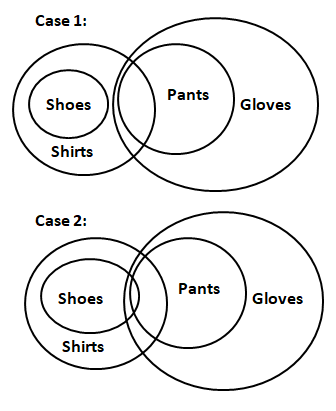In each question given below, there are three statements followed by four conclusions numbered I, II, III and IV. You have to take the given statements to be true even if they seem to be at variance with commonly known facts and then decide which of the conclusion(s) logically follows from the given statements.
Statements:
a. Some shirts are pants.
b. All shoes are shirts.
c. All pants are gloves.
Conclusions:
I. Some shoes are gloves.
II. Some shirts are gloves.
III. No pants are shoes.
IV. All gloves are shirts.
Solution
There are two cases possible as drawn below.

From case 1 diagram, we can see that it's not necessary for some shoes to be gloves. Hence, conclusion I doesn't follow.
From both diagrams, we can see that it is necessary for some shirts to be gloves. Hence, conclusion II follows.
From case 2 diagram, we can see that some pants can be shoes. Hence, conclusion III doesn't follow.
From both diagrams, we can see that it is not necessary for all gloves to be shirts. Hence, conclusion IV doesn't follow.
Therefore, option A is the correct answer.
Video Solution

Click on the Email ☝️ to Watch the Video Solution
Create a FREE account and get:
- All Quant Formulas and shortcuts PDF
- 170+ previous papers with solutions PDF
- Top 5000+ MBA exam Solved Questions for Free

